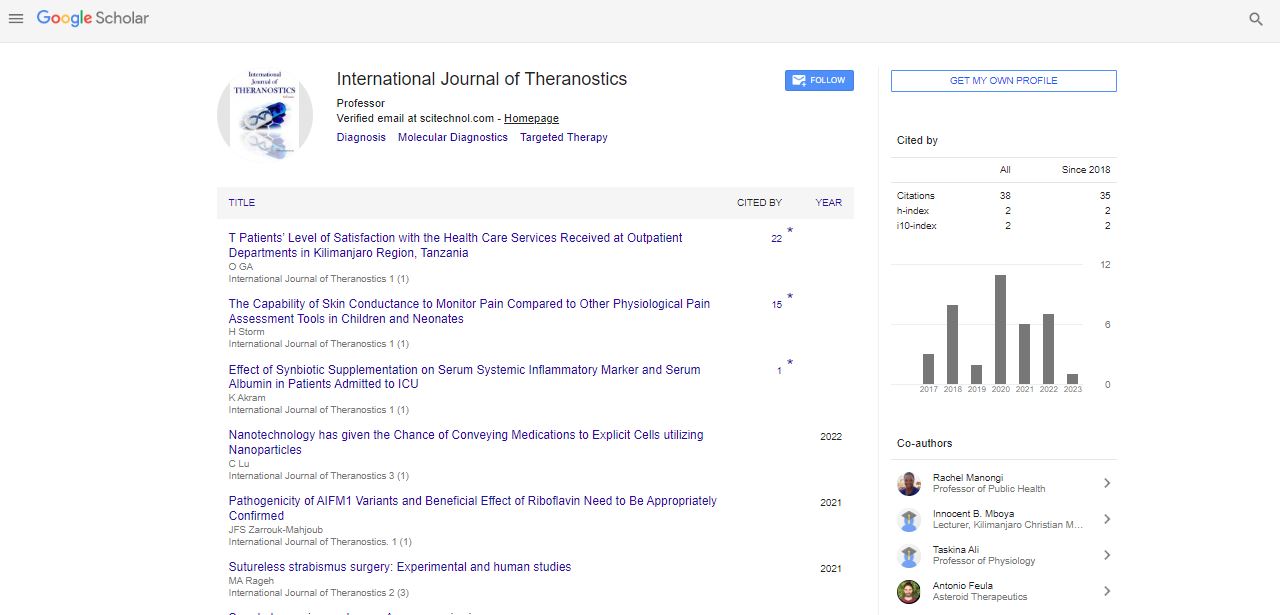Perspective, Vol: 12 Issue: 1
Image-Guided Therapy: The Advancements and Benefits for Patient Treatment
Jia Duan*
1Department of Ultrasound Medicine, University of Electronic Science and Technology of China, Mianyang, China
*Corresponding Author: Adamantia Nikolaidi, Oncology Clinic
Department of Ultrasound Medicine, University
of Electronic Science and Technology of China, Mianyang, China
E-mail: duanjia@scut.edu.cn
Received date: 20 February, 2023, Manuscript No. IJT-23-93133;
Editor assigned date: 23 February, 2023, Pre QC No. IJT-23-93133 (PQ);
Reviewed date: 09 March, 2023, QC No. IJT-23-93133;
Revised date: 16 March, 2023, Manuscript No: IJT-23-93133 (R);
Published date: 23 March 2023, DOI: 10.4172/Ijt.1000117.
Citation: Duan J (2023) Image-Guided Therapy: The Advancements and Benefits for Patient Treatment. Int J Theranostic 12:1.
Description
IGT has advanced significantly in recent years, with the development of new imaging technologies and the integration of robotic systems. The use of 3D imaging and virtual reality technologies has allowed healthcare providers to have a more precise view of the patient's anatomy, which has improved the accuracy and success of surgical and medical interventions. Additionally, the integration of robotic systems has enabled healthcare providers to perform complex procedures with greater precision and control.
Another significant advancement in IGT is the development of realtime imaging technologies, such as Magnetic Resonance Imaging (MRI) and Computed Tomography (CT) scans. These technologies enable healthcare providers to monitor the patient's condition during the procedure in real-time, making it easier to make adjustments and ensure that the treatment is successful.
There are several benefits of IGT for both patients and healthcare providers. One of the most significant benefits is the minimally invasive nature of the procedure. Compared to traditional surgery, IGT involves smaller incisions, which results in less pain, reduced risk of infection, and shorter recovery times for the patient.
Another benefit of IGT is the increased accuracy and success rate of surgical and medical interventions. With the use of advanced imaging technologies and robotic systems, healthcare providers can target specific areas of the body with greater precision, reducing the risk of damage to healthy tissue and organs.
Finally, IGT can also reduce the cost of patient treatment. By reducing the risk of complications and the need for extended hospital stays, IGT can save money for both patients and healthcare providers.
While there are many benefits to IGT, there are also several challenges that healthcare providers face when implementing this technology. One of the most significant challenges is the cost of the equipment and training. The technology used in IGT is expensive, and healthcare providers need specialized training to use it effectively.
Another challenge is the need for collaboration between healthcare providers from different specialties. IGT often involves a team of healthcare providers from different specialties, including radiologists, surgeons, and anesthesiologists. This requires effective communication and coordination to ensure that the procedure is successful.
Finally, there is also a need for continued research and development in IGT. As the technology continues to evolve, healthcare providers need to stay up-to-date with the latest advancements and techniques to ensure that they offer the best possible care for their patients.
IGT is a rapidly evolving field that offers many benefits to patients and providers. The use of advanced imaging technology and robotic systems allows healthcare providers to perform surgical procedures and medical procedures with greater precision and control, reducing patient pain, shortening recovery time, and improving patient outcomes. Costs are reduced. Although there are challenges in implementing IGT, continued research and development in this area will lead to further advances in patient care.
 Spanish
Spanish  Chinese
Chinese  Russian
Russian  German
German  French
French  Japanese
Japanese  Portuguese
Portuguese  Hindi
Hindi 